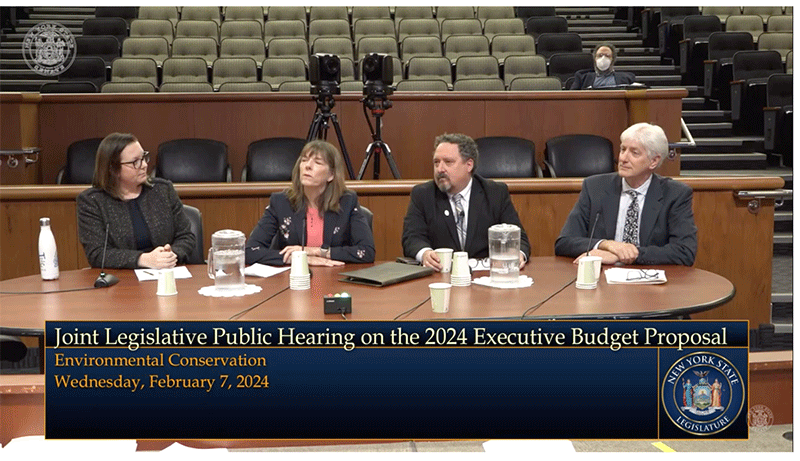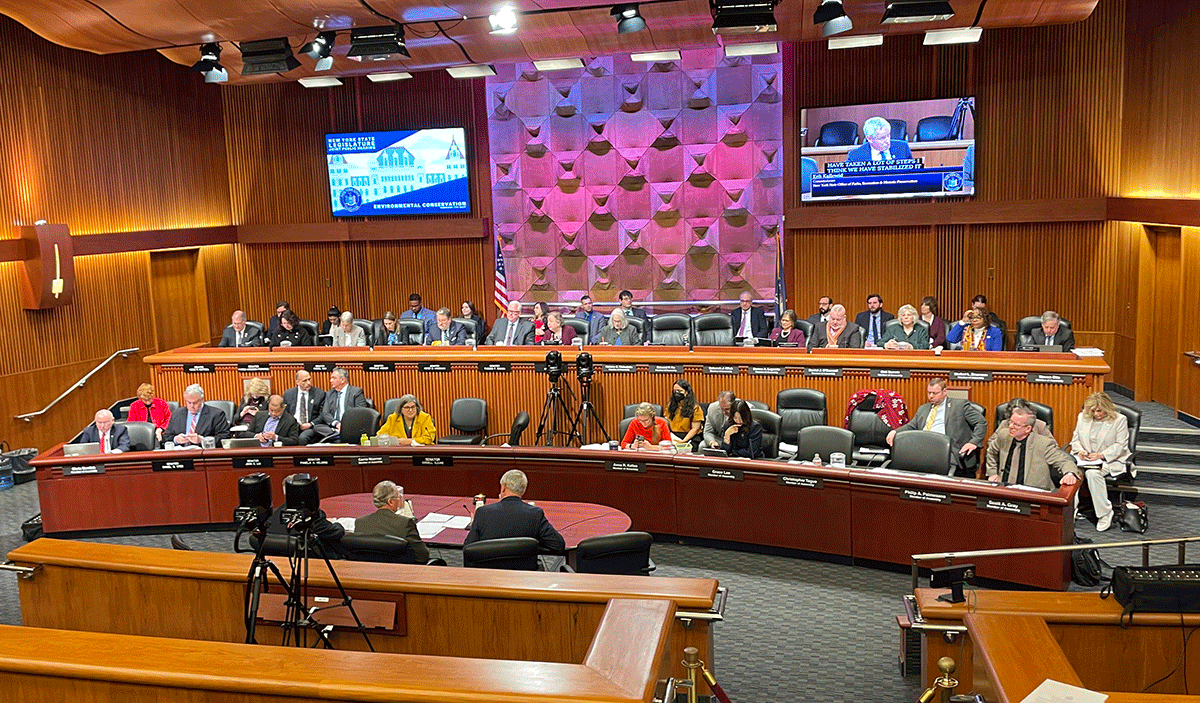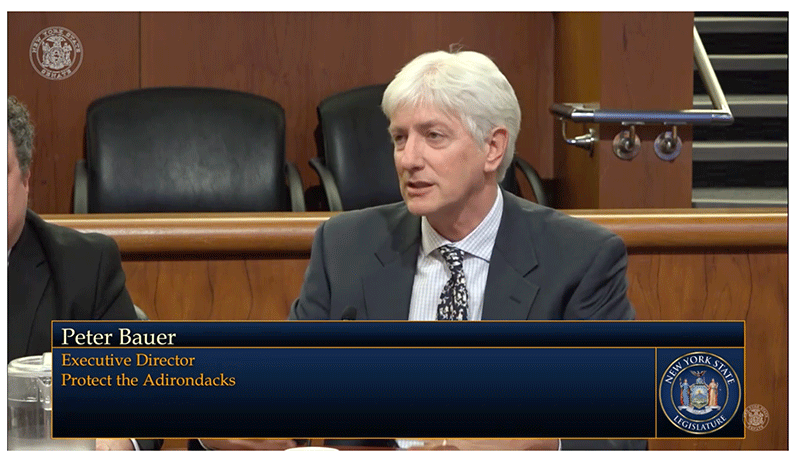February 2, 2024
Hon. Liz Krueger
Chair, Senate Finance Committee
New York State Senate
172 State Street, The Capitol, Room 416
Albany, NY 12247
Hon. Helene E. Weinstein
Chair, Assembly Ways and Means Committee
Legislative Office Building 711-A
Albany, NY 12248
Dear Senator Krueger and Assembly Member Weinstein:
Protect the Adirondacks, Inc. (PROTECT) is pleased to submit this written testimony concerning the FY2025 Executive Budget. PROTECT is a non-profit grassroots membership organization dedicated to the protection, stewardship, and sustainability of the natural environment and human communities of the Adirondack Park. PROTECT uses advocacy, independent public oversight, grassroots organizing, education, scientific research, and legal action to advance its mission. PROTECT has over 2,000 members and supporters who share a common desire to protect the environmental health and legacy of the Adirondack Park. Many of PROTECT’s members reside or own property within the Park. PROTECT’s members are also regular users of and visitors to the Forest Preserve who recreate in and enjoy the natural resources and scenic treasures of the Adirondack Park.
1. Environmental Protection Fund
The Environmental Protection Fund (“EPF”) is the main source of funding for stewardship of public lands within the Adirondack Park and for the environmentally sound economic development of communities in the Park. While we are pleased that Governor Kathy Hochul’s proposed budget includes $400 million for the EPF, this figure has remained stagnant since FY2023, despite the increasingly serious environmental challenges facing the State and the increased costs of responding to those challenges.
Accordingly, PROTECT urges the Legislature to increase EPF funding to $500 million for FY2025.
EPF Open Space and Land Acquisition: As you know, in 2022 the Legislature passed and Governor Hochul signed the landmark “30 by 30” law, which commits the State to protecting 30% of the State’s lands and inland waters by 2030. Last year, PROTECT issued a report that documented all currently protected lands in the State and concluded that in order to reach the 30 by 30 goal the State will need to protect an additional 3.2 million acres over the next six years.[1] Despite this fact, the Executive Budget proposed to decrease EPF funding for Open Space and Land Conservation by over $4 million (from $38,900,000 to $34,500,000).
PROTECT urges the Legislature to increase EPF funding for Open Space and Land Acquisition to $100 million if the EPF remains at $400 million and to $200 million if the EPF is increased to $500 million.
EPF State Land Stewardship: The State Land Stewardship line in the EPF provides funds for the management and protection of millions of acres of State-owned lands in the State, including the nearly 3 million acres of State-owned Forest Preserve lands in the Adirondack and Catskills Parks. Although the Adirondack Park State Land Master Plan requires the Department of Environmental Conservation (DEC) to conduct a carrying capacity study[2] for each unit of Forest Preserve lands and waters in the Park, DEC has failed to complete even one such study, citing budgetary constraints. More investment will support good paying jobs and promote tourism and quality of life benefits for the communities that serve as gateways to these wildland resources. The Executive Budget proposed to decrease this critical funding by $500,000, from $47,525,000 to $47,025,000.
If the EPF remains at $400 million, PROTECT urges the Legislature to increase EPF funding for State Land Stewardship to $50 million, including $1 million for a carrying capacity study of the Saranac Lakes Complex in the Adirondack Park and $10 million for Adirondack and Catskill visitor safety and wilderness protection. If the EPF is increased to $500 million, PROTECT requests that State Land Stewardship be funded at $65 million with the carrying capacity study and visitor safety and wilderness protection lines included.
EPF Diversity Funding: The Executive Budget would decimate recent diversity initiatives by eliminating funding for the Adirondack Diversity Initiative, funded last year at $420,000 (originally in the EPF but moved to the Aid to Localities), and the Timbuctoo Summer Climate and Careers Institute, which received $2.1 million in EFP funding last year. The Executive Budget also fails to include any funding for a planned new exhibit on the African-American Experience in the Adirondacks at the Adirondack Experience (formerly the Adirondack Museum) in Blue Mountain Lake.
The Adirondack Diversity Initiative works to make the Adirondacks a welcoming and inclusive place for both residents and visitors. Working with community members, local organizations and regional stakeholders, the Initiative creates tools, strategies and interventions that reduce the impacts of systemic racism that continue to plague the Adirondack region.
The Timbuctoo Summer Climate and Careers Institute[3] is a program developed by the SUNY College of Environmental Science and Forestry (ESF) to introduce high school sophomores and juniors from New York City to climate science, provide career counseling, and address issues of access from an equity and justice perspective. In 2023, the Institute partnered with CUNY Medgar Evers College to bring 48 high school students to the Adirondacks for three two-week sessions.
Proposed for a 2025 opening, the African American Experience in the Adirondacks would be a major permanent exhibition dedicated to the untold story of African Americans and their experiences, past and present, in the Adirondacks.
PROTECT urges the Legislature to restore funding for the Adirondack Diversity Initiative and the Timbuctoo Summer Climate and Careers Institute and to add $2 million for the African American Experience in the Adirondacks exhibit at the Adirondack Experience.

An environmental panel testifying in Albany on February 7, 2024 from (left to right) the Nature Conservancy, Open Space Institute, Sierra Club, and Protect the Adirondacks.
EPF Invasive Species: As the effects of climate change become more pronounced, New York State has experienced an unprecedented influx of terrestrial and aquatic invasive species. Unfortunately, the Executive Budget proposed to decrease funding to control and eradicate invasive species by approximately $1.5 million, from $18,550,000 to $17,000,000.
PROTECT urges the Legislature to increase invasive species funding by $1.5 million, from $18,550,000 to $20,000,000.
EPF Forest Preserve Research: Wildlife research in New York is heavily focused on game species because it is funded by hunting license revenues. As a result, Forest Preserve planners have little information about non-game wildlife populations on State lands. The recent killing of a wild gray wolf in upstate New York confirms the presence of this endangered species in the State, but DEC lacks funding to adequately assess the status and location of gray wolves in the State.
The Adirondack Watershed Institute at Paul Smith’s College in the Adirondack Park conducts water quality monitoring and invasive species management throughout the Park. The Institute’s mission is to protect clean water, conserve habitat and support the health and well-being of people in the Adirondacks through scientific inquiry, stewardship and real-world experiences for students.
PROTECT urges the Legislature to add $1 million to the EPF for wildlife research on State lands, including $500,000 to conduct a gray wolf status assessment, and $200,000 for each of the following institutions for research and monitoring: the Adirondack Watershed Institute; the Atmospheric Sciences Research Center Whiteface Mountain Field Station; and the Cary Institute for Ecosystem Studies.
EPF Implementation of Salt Reduction Task Force Recommendations: In 2023, the Adirondack Road Salt Reduction Task Force released its report documenting the significant adverse groundwater and surface water pollution effects of the use of road salt in the Adirondack Park. EPF funding is needed to implement the road salt reduction strategies identified in the Task Force’s report.
PROTECT urges the Legislature to add $500,000 to the EPF for the purpose of implementing road salt reduction strategies in the Adirondack Park.
2. Clean Water Infrastructure Act
Funding provided under the Clean Water Infrastructure Act (CWIA) is essential to protecting Adirondack Park waters and to promoting new business and affordable housing in Adirondack Park communities. Since 2016, New York State has invested nearly $100 million in clean water infrastructure projects for communities in the Adirondack Park, but the need is far greater. The current backlog of wastewater treatment plant and sewer system projects in Adirondack communities exceeds $200 million. In addition, failing private septic systems throughout the Park are compromising surface and groundwater quality. The CWIA’s Septic Replacement Fund provides funding to counties for financial assistance to homeowners who need to replace or upgrade failing septic systems.
PROTECT appreciates the proposal to provide more generous grants to small rural communities, but we oppose the decision to cut the fund in half.
This fund has historically received $500 million each year, but the Governor’s proposed Executive Budget cuts this amount in half. PROTECT urges the Legislature to provide $600 million for the Clean Water Infrastructure Act to assist both State-wide and Adirondack Park communities in addressing urgent and widespread clean water infrastructure needs.
3. Olympic Regional Development Authority (ORDA) Funding
The Executive Budget proposed $82.5 million in capital funding for ORDA, including $70 million to support modernization of the Olympic facilities and ski resorts. New York State has poured more than $600 million into ORDA over the past six years. New York also agreed to fund an additional $46.5 million in grants to bankroll last winter’s World University Games held in Lake Placid, and spent another $6.5 million helping refurbish Lake Placid’s Main Street. Taken together that’s more money than New York spent hosting the 1980 Winter Olympics. It’s also more money than the State committed, amid growing controversy, to help build a new NFL stadium in Buffalo, a city with a population more than 10 times that of the Lake Placid region.
ORDA manages three ski areas, and other facilities in Lake Placid. The three ski areas were authorized through a Constitutional amendments to Article 14, the Forever Wild clause. These amendments authorized ski trails and appurtenances to facilitate winter alpine ski recreation. ORDA has been pushing the envelope to build summer-type tourist attractions like “mountain coasters” and “zip lines” and new extreme mountainbiking parks. Such attractions are not authorized by Constitutional amendment and would be illegal and should not be part of the state budget.
Remarkably, when PROTECT inquired what projects would be paid for by the $82.5 million in capital funding proposed in the Executive Budget, ORDA did not identify the specific projects that would be built. At a time when funding for management and conservation of the nearly four million acres of State-owned Forest Preserve in the Adirondack and Catskill Parks is in dire need of substantial increases, the proposal to give ORDA tens of millions of dollars in taxpayer subsidies for as-yet unidentified projects should be revised with specific projects that can be scrutinized. PROTECT urges the Legislature to fund specific ORDA projects on state lands.
4. Make New York Greener Initiative
The Executive Budget includes $47 million to facilitate the planting of 25 million trees by 2033. Although this is touted as an effort to advance the State’s net zero carbon emissions goal under the Climate Leadership and Community Protection Act, the science makes clear that the amount of carbon dioxide sequestered by saplings planted between now and 2033 will be negligible in helping the State meet its net zero goals and pales in comparison to the amount of carbon sequestered by existing mature forests. According to the United States Geological Survey, the “continuing increasing growth rate means that on an individual basis, large, old trees are better at absorbing carbon from the atmosphere.”[4]
While PROTECT generally supports tree planting initiatives, if the goal of this funding is to enhance carbon sequestration, then the money would be better spent on providing long-term protection by protecting land with mature forests. Accordingly, PROTECT again urges the Legislature to increase EPF funding for Open Space and Land Acquisition to $100 million if the EPF remains at $400 million and to $200 million if the EPF is increased to $500 million.
5. Article VII Bills
PROTECT urges the Legislature to include the following bills in their one-house budget bills:
Wolf Protection Bill (S.7927 Hoylman-Sigal)/A.8295 (Carroll): Wolves historically inhabited much of the United States, but were extirpated by the early 1900’s from much of their range, including in New York State, due to intentional eradication campaigns. Wolves are ecologically essential for healthy natural ecosystems and can travel hundreds of miles to reestablish territories if sufficient legal protections are in place to allow them safe passage. Over the past few decades, wolves have periodically migrated from the Great Lakes and Canada into New York and other northeastern states. However, due to the similarity in appearance between wolves and large eastern coyotes, these animals have been and will continue to be killed by hunters and trappers. The most recent incident was the killing of a gray wolf near Cooperstown in 2021 which the hunter mistook for a large coyote.
Because wolves are protected as an endangered species under both federal and New York State law, there is a critical need for specific on-the-ground actions to prevent future killings due to mistaken species identity. This bill will further protection of wolves by authorizing the Department of Environmental Conservation (DEC) to collect DNA data from large canids (coyotes or potentially wolves) taken by hunters in New York that will provide crucial information on the location and prevalence of wolves and large coyotes in the State. Hunters and trappers will be required to report to DEC coyotes they have taken, so that DEC will have details about the animals, how many are taken, and where they are located when they are taken. This reporting is similar to what hunters and trappers already do for other animal species. Coyotes weighing greater than 50 pounds or having other physical characteristics indicative of a wolf will be subjected to a DNA analysis by DEC to determine the genetic composition of the animal. If the DNA analysis shows that the animal is a wolf, then DEC may impose a temporary moratorium on the killing of wild canids in a specific area to protect any potential wolves in the area. DEC will decide the length of time and the location of the moratorium. The legislation does not reduce the hunting season or decrease bag limits for hunters and trappers lawfully killing coyotes or other game animals in New York State.
Road Salt Applicator Training Program (S.5384 Harckham/A.6018 Shimsky): This bill (S.5384/A.6018) will implement some of the recommendations of the Adirondack Road Salt Reduction Task Force by establishing a Department of Transportation (DOT) training program to educate road salt applicators about the adverse environmental and human health effect of road salt; best practices and alternatives to reduce road salt application; how to use state of the art equipment for snow and ice removal; and the use of monitoring technologies for annual reporting of road salt application by location. This bill will also require the DOT to prepare a report with recommendations for funding options to localities for the purchase of state-of-the-art equipment and identifying locations in the State where road salt contamination may be a threat to the environment, property or human health. The DOT road salt applicator training program is necessary to ensure that best practices are followed in the Adirondacks and elsewhere across the State.
Title Insurance for Land Acquisition (S.6606 May/A.7372 Thiele): This bill will authorize the New York State Attorney General’s Office to approve certain state land acquisitions made for the purposes of land conservation, and to accept a title insurance policy from a title company to insure the State against possible defects in the chain of title for the property acquired. Currently, there are substantial backlogs and delays in researching the chain of title to the property under consideration for acquisition. This bill would authorize the Attorney General’s Office to accept title insurance from a title insurance company that has already researched the chain of title for the property being acquired. Having this authority will accelerate the state’s process for conserving land. The acceleration of this process is particularly critical to meet the State’s goals as set forth in the State’s 30 by 30 law, as well as to meet the State’s goals in the Climate Action Plan and to expend the funds in the Environmental Bond Act for land acquisition.
On behalf of the Board of Directors of the Protect the Adirondacks, please let me express our gratitude for the opportunity to submit this budget testimony.
Sincerely,
Peter Bauer
Executive Director
Click here to watch the environmental budget hearings.
[1] PROTECT’s report, “20% in 2023: An Assessment of the New York State 30 by 30 Act,” is available at Protect-the-Adirondacks-30-by-30-Report-web.pdf (protectadks.org).
[2] “Carrying capacity” means the ability of natural resources to withstand and sustain human activity and the environmental impacts resulting from those activities. Information concerning the critical need for DEC to complete a carrying capacity study of the Saranac Lakes Complex can be found at Carrying Capacity study needed for the Saranac Chain of Lakes – Protect the Adirondacks! (protectadks.org).
[3] A description of the Timbuctoo Summer Climate and Careers Institute, a collaboration between SUNY College of Environmental Science and Forestry (ESF) and CUNY Medgar Evers College (MEC) in cooperation with other partners, is available at https://www.esf.edu/news/2023/esf_timbuctoo_institute.php.
[4] Available at Large Old Trees Grow Fastest, Storing More Carbon | U.S. Geological Survey (usgs.gov).







